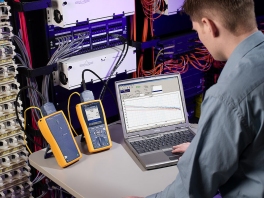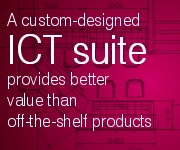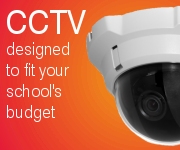We certify our work to TIA/EIA-568-B
Overview
Whether we are adding a single data-point or a whole ICT suite, we test and certify every connection to TIA/EIA-568-B. The tests are much thorough than basic continuity tests, and include tests for wire-map, propagation delay, delay skew, cable length, attenuation, NEXT, ELFEXT and speed. We also conduct 'real-world' data tests as a further validation. Successful completion of these test enables us to guarantee that an installation is capable of handling the applications for which it is intended.
Why testing is necessary
Network cables have to be routed through buildings, often passing through holes in walls, through conduit, past fluorescent lights, across electrical cables, making twists and turns along the way. Each of these elements presents a physical and/or electrical challenge for a network cable, which is why every network connection that we do is subjected to a rigorous set of tests to verify that the cable and connections perform as we expect. The tests that we carry-out are listed below:

Wire-map test
This identifies physical errors such as shorts between wires, continuity, crossed pairs, reversed pairs and any other mis-wiring. An important test because in an installation of 50 network cables, there will be 800 individual wires to terminate.
Propagation delay test
Tests the time it takes for a signal to be sent from one end and received by the other end. Propagation delay will increase with cable length due to a combination of capacitance between pairs and the inductive effect of an electrical current passing through a magnetic field.
Delay skew test
This tests the difference in propagation delay between the fastest and slowest set of wires. Ideal value would be less than 50 nanoseconds over a 100 metre cable. The reason that the propagation delay varies between pairs is typically due to the difference in length between twisted pairs. Ie, one pair may be twisted tighter than another, thereby increasing the length of the cable.
Cable length test
Verifies that the length of the cable from transmitter to receiver does not exceed 100 metres (the upper limit for a 10/100/100baseT network). The test works by applying a pulse at one end, measuring the time it takes for the pulse to be reflected back to the same end in nanoseconds, dividing it by two and multiplying the result by the speed of light to calculate the number of metres the signal has travelled.
Attenuation test
This measures the loss of signal strength at the far end of the cable compared to the signal that was introduced into the line. The loss is due to electrical resistance of the copper cable (seen at all frequencies), losses through the cable insulation (again constant for all frequencies) and impedance (increases with frequency). The test is conducted at the maximum designed data rate for the cable in question.
Near-End Crosstalk (NEXT) test
This tests for the signals from one pair radiating onto another pair causing unwanted interference. The test measures the difference between the signal induced on one pair and the crosstalk received on another pair, so the higher the difference, the better the cable performance.
Equal-level Far-End Crosstalk test
Similar to the NEXT test except that the signal is induced at one end and measured at the other. Impedance diminishes crosstalk with distance, so FEXT is not as impactive as NEXT, but must be tested for nevertheless.
Speed test
This is not one of the tests defined in TIA/EIS-568-B, but one that we carry out. This test sends large volumes of data at the maximum data-rate through the cable, and verifies that the data is received at the other end, error-free. This is the final validation that the cable is capable of carrying data at the maximum data rate.
Certification
Upon successful completion of the above tests, we will certify the cable for use at it's assigned data rate.
Overview
Whether we are adding a single data-point or a whole ICT suite, we test and certify every connection to TIA/EIA-568-B. The tests are much thorough than basic continuity tests, and include tests for wire-map, propagation delay, delay skew, cable length, attenuation, NEXT, ELFEXT and speed. We also conduct 'real-world' data tests as a further validation. Successful completion of these test enables us to guarantee that an installation is capable of handling the applications for which it is intended.
Why testing is necessary
Network cables have to be routed through buildings, often passing through holes in walls, through conduit, past fluorescent lights, across electrical cables, making twists and turns along the way. Each of these elements presents a physical and/or electrical challenge for a network cable, which is why every network connection that we do is subjected to a rigorous set of tests to verify that the cable and connections perform as we expect. The tests that we carry-out are listed below:

Wire-map test
This identifies physical errors such as shorts between wires, continuity, crossed pairs, reversed pairs and any other mis-wiring. An important test because in an installation of 50 network cables, there will be 800 individual wires to terminate.
Propagation delay test
Tests the time it takes for a signal to be sent from one end and received by the other end. Propagation delay will increase with cable length due to a combination of capacitance between pairs and the inductive effect of an electrical current passing through a magnetic field.
Delay skew test
This tests the difference in propagation delay between the fastest and slowest set of wires. Ideal value would be less than 50 nanoseconds over a 100 metre cable. The reason that the propagation delay varies between pairs is typically due to the difference in length between twisted pairs. Ie, one pair may be twisted tighter than another, thereby increasing the length of the cable.
Cable length test
Verifies that the length of the cable from transmitter to receiver does not exceed 100 metres (the upper limit for a 10/100/100baseT network). The test works by applying a pulse at one end, measuring the time it takes for the pulse to be reflected back to the same end in nanoseconds, dividing it by two and multiplying the result by the speed of light to calculate the number of metres the signal has travelled.
Attenuation test
This measures the loss of signal strength at the far end of the cable compared to the signal that was introduced into the line. The loss is due to electrical resistance of the copper cable (seen at all frequencies), losses through the cable insulation (again constant for all frequencies) and impedance (increases with frequency). The test is conducted at the maximum designed data rate for the cable in question.
Near-End Crosstalk (NEXT) test
This tests for the signals from one pair radiating onto another pair causing unwanted interference. The test measures the difference between the signal induced on one pair and the crosstalk received on another pair, so the higher the difference, the better the cable performance.
Equal-level Far-End Crosstalk test
Similar to the NEXT test except that the signal is induced at one end and measured at the other. Impedance diminishes crosstalk with distance, so FEXT is not as impactive as NEXT, but must be tested for nevertheless.
Speed test
This is not one of the tests defined in TIA/EIS-568-B, but one that we carry out. This test sends large volumes of data at the maximum data-rate through the cable, and verifies that the data is received at the other end, error-free. This is the final validation that the cable is capable of carrying data at the maximum data rate.
Certification
Upon successful completion of the above tests, we will certify the cable for use at it's assigned data rate.


